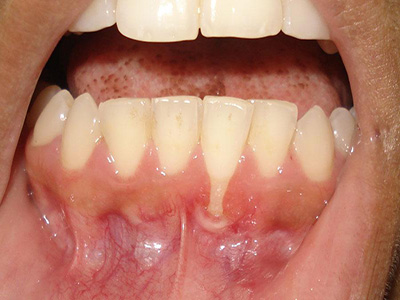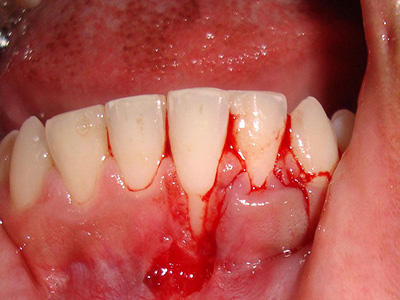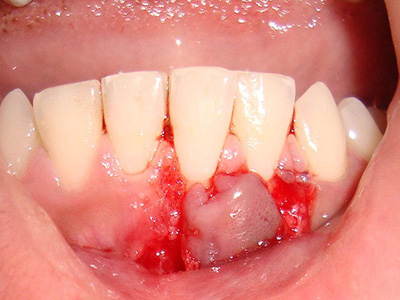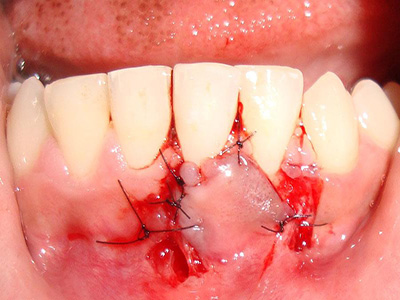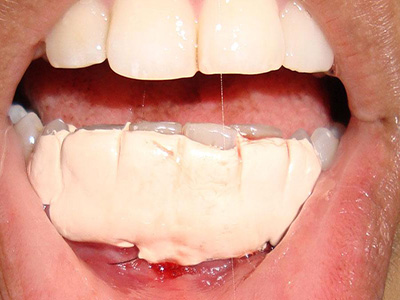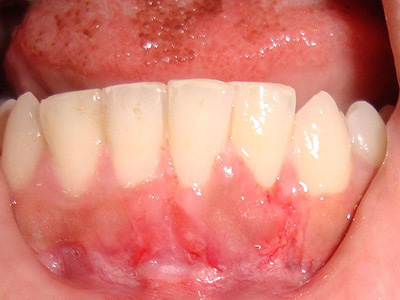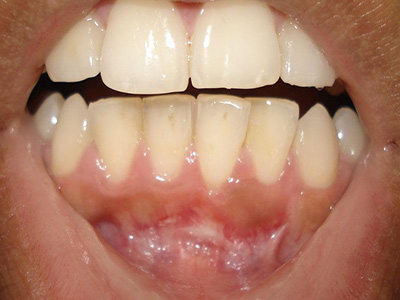Previous Issues Volume 1, Issue 1 - 2016
Think Pink: An Esthetic Root Coverage with Laterally Displaced Flap
Shivani Sachdeva1, Mangesh Phadnaik2, Harish Saluja1, Parul Tandon1
1Assistant Professor at Pravara Rural Dental College and Hospital.
2Professor and guide G.D.D Nagpur.
Corresponding Author: Shivani Sachdeva, Department of Periodontics Pravara Rural Dental College and Hospital, Tel: 09730548805; E-Mail: [email protected]
Received Date: 26 Mar 2016 Accepted Date: 14 Apr 2016 Published Date: 22 Apr 2016
Copyright © 2016 Sachdeva S
Citation: Sachdeva S, Phadnaik M, Saluja H and Tandon P. (2016). Think Pink: An Esthetic Root Coverage with Laterally Displaced Flap. Mathews J Case Rep 1(1): 004.
ABSTRACT
BACKGROUND
Complete root coverage is one of the primary objectives to be considered when treating gingival recessions. Furthermore, aesthetic demands can be satisfied by soft tissue grafts, the thickness and color of which should not be distinguishable from those of adjacent soft tissue.
CASE REPORT
This article describes a case report in which a split pedicle graft technique has been used for root coverage in relation to mandibular left central incisor with Miller class II gingival recession. Complete root coverage was seen on 15 day and on 6 month.
KEYWORDS
Gingival Recession; Root Coverage; Pedicle Graft.
INTRODUCTION
Gingival recession is the displacement of marginal gingival tissue apical to the cemento-enamel junction with exposure of root surface to the oral environment [1]. The gingival recession is found most commonly on facial and buccal surface as a result of vigorous tooth brushing, whereas it may affect other tooth surfaces also because of poor oral hygiene [2]. It has been proposed that recession is multi-factorial, with one type being associated with anatomic factors such as bone dehiscence, malpositioning of teeth, trauma associated with malocclusion. Another type of recession is associated with physiological (aging) or pathological factors (where it occurs as part of pathogenesis of periodontal disease or smoking) [2-4]. More than 50% of population has one or more sites of gingival recession = 1 mm3. The process by which gingival recession occurs is still unclear; however, it seems that gingival recession probably occurs in the presence of inflammation. Tissue destruction in plaque-induced periodontal disease in different scenarios causes apical migration of the epithelium and destruction of the periodontal ligament along with bone resorption. Therefore, gingival recession may be a consequence of this stage of disease, or it may be seen as a part of the healing process in response to periodontal treatment. Which results in reduction of probing depth and shrinkage of the tissue that leads to tightening of the gingival cuff and formation of long junctional epitelium [2]. In studying the etiology of gingival recession Gronman concluded that tooth malalignment and tooth brushing are most common factors associated with gingival recession [5]. Sangnes and Gjermo confirmed that different types of traumatic injuries may result in a variety of gingival lesions [6]. The lateral pedicle graft was described by Grupe and Warren in 1956 [7]. The purpose was to gain attached gingiva and to cover areas of gingival recession, especially those on the facial surfaces of mandibular anterior teeth. The lateral positioned flap can be used to cover the isolated, denuded roots that have adequate donor tissue laterally and vestibular depth. Prognosis for Miller class I and class II is good to excellent whereas,partial root coverage can be expected for class III and class IV has very poor prognosis with current techniques.
CASE REPORT
A 23-year old healthy female presented to the department of periodontics, government dental college Aurangabad with chief complaint of receding gum in the lower front teeth region. On examination there was Miller's class II gingival recession in the lower left central incisor region with a recession of 6mm in depth and 2 mm in width it was due to malposition. Trauma from occlusion with respect to the involved tooth was ruled out clinically (Figure 1).
Figure 1:ILabial View showing Class II Miller's gingival recession with left central incisor.
Pre Surgical Protocol
Patient was motivated and educated and oral hygiene instructions were given. Scaling and root planing was done and the patient was periodically recalled to assess his oral hygiene and gingival status before taking up the case for periodontal surgery and allowing the creeping attachment for 3-4weeks. Blood and radiographic investigation was carried out. No interproximal bone loss was seen.
Prepare the Recipient Site
The root surface was thoroughly scaled and planned to remove plaque, accretions and surface irregularities. Profound analgesia was obtained using local anesthesia for the recipient site. A no.15 scalpel blade was used to prepare the recipient bed. The epithelium was dissected preserving the connective tissue for the graft acceptance in the coronal-apical direction several millimeters below the mucogingival junction. The high frenum attachment was relieved thereafter (Figure 2).
Preparation of Donor Site
The donor flap should be at least one and the half times the size of the recipient area to be covered to avoid the shrinkage later on. The root coverage over left central incisor was covered by pedicle graft from lateral incisor by giving incision around the lateral incisor such that interdental papilla was preserved and partial thickness flap was taken to cover the denuded root, removing the adjacent epithelium and partial connective tissue in order to preserve the periosteal bed over the donor site. The vertical incisions are extended far apically into the mucosal tissue to permit adequate mobility of the flap. The base of the flap must be wide to permit adequate vascularity. The flap was sharply dissected, giving the acute angled incisions at the base of interdental gingiva over both the sides and collar of marginal gingival was relieved. This helped in obtaining graft with two hook shaped extensions of marginal collar, making sure to carefully preserve the interproximal papilla (Figure 2, 3).
Figure 2:Recipient bed was prepared and donor flap was prepared.
Figure 3:Pedicle graft was mobilized.
Preparation of Pedicle Flape
A partial thickness pedicle was raised using sharp dissection, the flap should be free enough to permit movement to the recipient site, with no tension. The pedicle flap was rotated and positioned coronally 1 to 2mm on the enamel of the recipient site. Suturing was done using 4-0 catgut suture with a fine noncutting edge needle to minimize laceration (Figure 4).
Figure 4:Pedicle flap was sutured and stabilized.
One sling suture was placed, to pull the papilla interproximally and hold the tissue tightly against the neck of the tooth. Second suture was two periosteal sutures, which were given on both the sides. The third suture was papillary suture, where the pedicle flap was stabilized from interproximal papilla. The flap lied passively with no tension and was pink. Pressure was applied to the flap with gauze sponge for three to four minutes to create fibrinous union. The area was protected with Coe-Pack (Figure 5).
Figure 5:Periodontal dressing was given.
Post Operative Instructions
Patient was instructed to take analgesics and antibiotics and was asked to discontinue the tooth brushing around the surgical site during the initial 15 days after surgery. During this period plaque control was achieved with a 0.2% chlorhexidine mouth rinse used twice a day. After this period, gentle tooth brushing with modified stillman technique using a soft bristle tooth brush was allowed. Uneventful healing was seen after 15 days and sixth month post operative visits (Figure 6, 7). A gain of CAL of 6mm was seen at the sixth month post operative visit.
Figure 6:Root coverage showing gain in clinical attachment level after 15 days.
Figure 7:Complete root coverage after 6 months.
Healing of Graft
Healing of pedicle soft tissue grafts in the areas surrounding the recession defect, i.e. where the recipient bed consists of bone covered by connective tissue, the pattern of healing is similar to that observed following a traditional flap operation. Cells and blood vessels from the recipient bed as well as from the tissue graft invade the fibrin layer, which gradually becomes replaced by connective tissue. As early as 1 week later a fibrous reunion is established between the graft and the underlying tissue.
DISCUSSION
Root coverage of severe gingival recession has become an important treatment modality because of the increasing demand for cosmetic and functional treatment [8]. Over the past decades a variety of regenerative procedures have been used to correct gingival recession. Laterally positioned flap have been widely used since Grupe and Warren introduced this method for the treatment of localized gingival recession [7]. In this procedure, the adjacent keratinized gingiva is positioned laterally, and the surface of the localized gingival recession is covered. The disadvantage of this method is possible bone loss and gingival recession on the donor site but in order to prevent that we preserved the interental papilla and had taken partial thickness flap to improve the likelihood of survival of bone covering the donor root. The majority of these procedures consist of periodontal plastic surgical (mucogingival) graft techniques, either alone or in combination with guided tissue regenerative procedures [2]. Various treatment protocols include free gingival autograft, free connective tissue autograft, Pedicle grafts (Laterally positioned, coronally positioned, semilunar pedicle [Tarnow]), subepithelial connective tissue graft, GTR, Pouch and tunnel technique [7, 9-11]. Guinard and Caffesse reported an average of 1mm of postoperative gingival recession on the adjacent donor site which was not observed in our case report [12]. Lateral pedicle flap is contraindicated where the width, height and thickness of the adjacent keratinized gingiva of the donor tissue is inadequate or where an osseous dehiscence or fenestration exists. Many modification methods of Grupe and Warren have been developed to avoid gingival recession at the donor site. Staffileno advocated the use of a partial thickness flap to avoid the recession at the donor site, this was the technique which we followed for our case [13]. Grupe reported a modified technique to preserve the marginal gingiva by the making a submarginal incision at the donor site [14]. However, laterally positioned full thickness flaps have best prognosis for the exposed root surface coverage. Knowles and Ramfjord used a free autogenously gingival grafts to cover the donor site [15]. Espinel and Caffesse compared these two procedures and found minimal gingival recession on the donor site with the free autograft gingival graft [16]. They found that if the free gingival autogenous grafts was used, there was no reduction in the width of the keratinized gingiva on the donor site. If the free gingival autogenous graft was not used, more than 1mm of keratinized tissue on the donor site was lost. Therefore, laterally repositioned flap with free autogenous grafts on the donor site is most favored currently. Studies on clinical root coverage by the laterally positioned flap reported about 70% of success rate [17].
CONCLUSION
The case reported here shows that lateral pedicle graft by Staffileno13 technique in Miller class II gingival recession. It is an effective treatment modality for the management of recession defects affecting teeth in the esthetic zones of the mouth specially for mandibular molars. The results manifestly showed complete root coverage.
REFERENCES
- Daprilen G, Gatto MR and Checchi L. (2007). The evaluation of buccal gingival recession in a student population; A 5- years follow up J Periodontol. 78(4), 611-614.
- Tugnait A and Clerehugh V. (2001). Gingival recession- Its significance and management. J Dent. 29(6), 381-389.
- Kassab M and Cohen RE. (2003). The etiology and the prevalence of gingival recession J Am Dent Assoc. 134(2), 220-225.
- Serino G, Wennstrom JL, Lindhe J and Eneroth L. (1994). The prevalence and distribution of gingival recession in subjects with a high standard oral hygiene. J Clin Periodontol. 21(1), 57-63.
- Gornman WJ. (1967). Prevalence and etiology of gingival recession J periodontal. 38(4), 316-322.
- Sangnes G and Gjermo P. (1976). Prevalence of oral soft and hard tissue lesions related to mechanical tooth cleaning procedure. Community Dent Oral Epidemiol. 4(2), 77-83.
- Grupe HE. (1956). Warren RE Repair of gingival defects by a sliding flap operation. J Periodontol. 27, 92-95.
- Langer B and Langer L. (1985). Subepithelial connective tissue graft technique for root coverage. J Periodontal. 56(12), 715-720.
- Nabers JM. (1966). Free gingival grafts. Periodontics. 4, 243- 245.
- Bernimonlin JP, Luscher B and Muhlemann HR. (1975). Coronally positioned flap. Clinical evaluation after one year. J Clinic Periodontal. 2(1), 1-13.
- Allen AL. (1994). Use of the supraperiosteal envelope in soft tissue grafting for root coverage. Int J Periodontics Restestorative Dent. 14(3), 217-227.
- Guinard EA and Caffesse RG. (1978). Treatment of localized gingival recessions. Part I. Lateral sliding flap. J Periodontol. 49(7), 351-356.
- Staffileno H. (1964). Management of gingival recession and root exposure problems associated with periodontal disease. Dent Clin North Am. 8,111-120.
- Grupe HE. (1966). Modified technique for the sliding flap operation. J Periodontol. 37(6), 49-495.
- Knowles J and Ramfjord S. (1971). The lateral sliding flap with the free gingival graft. The University of Michigan School of Dentistry, Video Cassette.
- Espinel MC and Caffesse RG. (1981). Comparison of the results obtained with the laterally positioned pedicle sliding flap- Revised technique and the laterally sliding flap with a free gingival graft technique in the treatment of localized gingival recessions. Int J Periodontics Restorative Dent. 1(6), 31-38.
- Nevins M and Cappetta E. (1998). An overview of mucogingival surgery to cover the exposed root surface. In: Nevins M, Mellonig J, eds. Periodontal Thearpy: Clinical Approaches and Evidences of Success. Hanover Park IL: Quintessence Publishing. 339-354.
